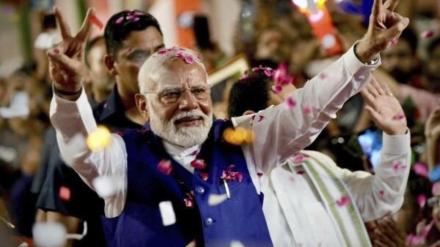Narendra Modi became Prime Minister for a historic third time, and the only incumbent after Jawaharlal Nehru to be re-elected for three consecutive terms. In this year’s election, the National Democratic alliance (NDA) won majority seats and formed a coalition government. This government is therefore different from the one that came to power in 2019, when the Bharatiya Janata Party (BJP) secured a majority on its own. Similarly, in comparison to 2019, the opposition has emerged stronger. The Indian National Developmental Inclusive Alliance (INDIA) bloc got 232 seats, in which the Congress emerged as the nucleus with a share of 99 seats. So in the coming days, the challenges in Parliament, politics, and governance will be new for both the alliances — in power and opposition.
For the alliance in power, the main challenge will be to retain cohesiveness collectively and maintain a consensus among all the coalition partners. As we know, creating a balance of aspirations is the most difficult task in managing humans. However, PM Modi is known as a very effective communicator, a skill that should certainly help him in creating and maintaining consensus within the group. Author Swadesh Singh alludes to this in his recent book, Modian Consensus. Political analysts emphasise that Modi has had training in the Rashtriya Swayamsevak Sangh and his long-term experience of creating dialogical unity may help the NDA in building consensus.
The second challenge of the NDA government would be to proceed on its promised development agenda, encapsulated in the vision of Viksit Bharat for 2047, without any disruption or deviation caused by various assertions of the opposition. It has to work towards its goal of making India the third largest economy in a changed context in which the opposition is strong enough to put the brakes on its agenda and try to change its direction.
Thirdly, the alliance in power now has to fight from sansad (parliament) to sadak (road) with the opposition for fulfilling its promises to the public in the 2024 election. At the governance level it has to act, and politically it has to build public opinion in its favour of governance and political action. So, keeping the party organisations always alert, active, and free from power-driven inertia will be a constant challenge for the constituents of the NDA. The BJP needs an effective president — in addition to Modi, who is the governance and public face of the party. JP Nadda’s term as BJP president is over and he has been inducted in the Modi cabinet.
Fourthly, the ruling alliance needs to maintain credibility of the country’s institutions by countering the opposition’s charges and strategy of creating doubts through its effective politics. Historically, rumour as a weapon for mobilisation mostly remains in the hands of opposition, not ruling forces. In the present day, social media has emerged as a powerful weapon to cultivate rumour politics and professional YouTubers play a crucial role in this. Various editing techniques and artificial intelligence-generated tools are potent weapons in the hands of those engaged in deploying politics of doubt.
For the opposition too, the coming days will be full of challenges. It has to acquire an image of a positive and constructive opposition by raising people’s voices for strengthening a democracy of development. However, in its bid to project an anti-government image the opposition starts creating hurdles in the country’s development mission. Here the opposition needs to strike a balance between dissent and support in the interest of the marginalised.
Secondly, Rahul Gandhi has to play a triple role — as the leader of the Congress, leader of opposition in Parliament, and the lead face of the INDIA. As the leader of the Congress, he has to strengthen the party and, for that end, take an anti-BJP stance. But as the leader of the opposition, people may prefer to see a positive face that is committed to India’s development. The people may like to see a constructive attitude towards the BJP and the NDA’s development politics. Dissent for the sake of dissent may be not a good strategy for him, but dissent may be used for carving a development map of the nation. As the lead face of the INDIA, he has to support alliance partners for good causes but also oppose or maintain distance on issues such as corruption charges. In my view, this will be the most difficult task. In fact, maintaining a balance between idealism and pragmatism always remains a challenge for politicians.
Politically, Gandhi has to maintain consistency in his words and action throughout. It is needed for enhancing his trust capital as a leader. PM Modi has increased his trust capital in politics by creating a balance between words and action. Gandhi also has to maintain consistency in terms of political visibility. In this general election, the Congress owed its success to anti-incumbency votes which we view as negative votes. The party has a big challenge to evolve its positive vote in which constant dissent against the government may not contribute much. Gandhi has to balance opposition to the government with support based on issues.
The challenges for both the government and the opposition are enormous. We have to wait and see how both alliances are going to respond to their unique challenges. The forms or modes of responses that they choose may affect their image and go on to determine an increase or decrease in their public trust and credibility.
The author is Director at GB Pant Social Science Institute, Allahabad.
Disclaimer: Views expressed are personal and do not reflect the official position or policy of Financial Express Online. Reproducing this content without permission is prohibited.
